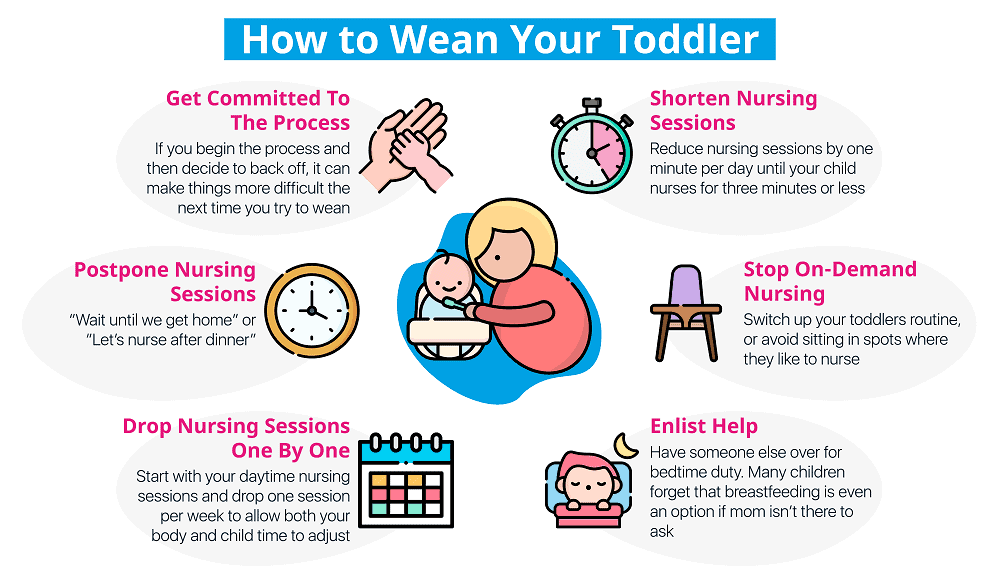But now you are ready to reclaim your body, yet you aren’t sure how to stop breastfeeding a toddler who can walk, talk, and demand milk.
We have been through this transition many times. It is entirely possible to stop nursing an older child without endless tears or drama. We will break down exactly how to wean a toddler and guide you through a six-step process to make the transition smooth for both of you.
Key Takeaways
- Weaning is the gradual process of stopping breastfeeding and transitioning your child to other food sources.
- Focus on offering nutrient-dense solids and healthy fats to replace the calories lost from breast milk.
- Toddlers view nursing as comfort, so you must replace the act with new soothing habits like snuggles, stories, or a special cup.
- Go slow. Gradual weaning protects your body from mastitis and helps your toddler manage their big emotions.
What to Know about Weaning
Before you start dropping feeds, you need to understand the three main pillars of weaning: your child’s nutrition, their emotional development, and your physical health.
How Will It Affect Their Nutrition?
You might worry about a nutritional gap once the milk stops flowing. It is tough to measure exactly how much milk a toddler gets, but some moms produce quite a bit of milk well into the second year.
Since breast milk provides calories, fat, and hydration, your main job is to offer adequate replacements. As you remove breast milk, you will likely see an increase in solid food intake. Focus on healthy fats (like avocados or full-fat yogurt) and calcium sources.
Do not stress about tracking every single bite, though.
Take Note
Aim for a nutritionally balanced week rather than a balanced day. Trust your child’s intuition. Your job is to provide healthy options at regular intervals; their job is to decide how much to eat.
How Will It Affect Their Development?
Toddlers thrive on routine. It makes them feel safe and secure. For your child, nursing is likely a major anchor in their daily rhythm.
When you take that away, you need to fill the void with a new form of security. You can do this by introducing a “transitional object” or a new soothing activity.
Here are a few comforting substitutes to help smooth the transition:
- Milk in a cool, new sippy cup they picked out at the store.
- A pacifier (only if they already use one; do not start now).
- A fun new water bottle for hydration.
- Reading a special book in a cozy chair.
- Listening to soft, soothing music.
- Five minutes of dedicated cuddle time.
When your toddler asks to nurse after you have dropped a session, offer the substitute immediately. You know your child best, so pick the distraction that usually works for them.
The good news? Toddlers are easily distracted. If they get upset because you said no to nursing, a quick pivot to a new activity or a snack often works wonders.
How Will It Affect You?
Weaning is not just hard on your child; it is physically demanding for you, too. Your breasts are essentially a factory accustomed to producing milk on demand.
As you drop sessions, your body will respond by making less milk. However, if you stop too abruptly, you risk painful engorgement, clogged ducts, and mastitis.
Keep an eye out for these symptoms of a clogged duct (1):
- A hard, tender lump in the breast.
- Swelling or localized bruising.
- Sensitivity to touch.
- Heat radiating from a specific spot.
If you find a lump, massage it firmly (even if it hurts), use warm compresses, and nurse on that side to clear the blockage.
If the pain gets worse or you feel flu-like symptoms, call your doctor immediately. You may have mastitis, which often requires antibiotics. Watch for these signs (2):
- High fever.
- Pus or discharge from the nipple.
- Chills and body aches.
- Extreme fatigue.
- Sudden onset of illness.
Weaning Step by Step
Now that you understand the science and emotions involved, let’s get into the practical side. Follow these six steps to wean your toddler with minimal tears.
1. Get Committed to the Process
This first step happens in your head. Weaning frees your body, but it marks the end of a very intimate era. You might feel relieved, but you might also feel sad or guilty.
Prepare yourself emotionally before you start. If you waver or send mixed signals, it confuses your child and makes the process harder. Decide you are done, and stick to the plan.
Always watch your child for cues. If you see a massive spike in toddler tantrums, you might be moving too fast. It is okay to hit pause for a week and let them adjust.
Editor's Note:
Michelle Roth, BA, IBCLC2. Talk to Your Toddler
Toddlers understand more than we give them credit for. Start talking about the change before it happens. Tell them that breastfeeding is for babies and they are becoming a big kid.
Set clear expectations. Let them know that soon, the milk will be all gone.
You can also introduce boundaries based on time or location. For example, explain that you only nurse when the sun is down, or only in the rocking chair. This helps break the habit of nursing anywhere, anytime.
Editor's Note:
Michelle Roth, BA, IBCLC3. Stop On-Demand Nursing
Many toddlers nurse simply because they are bored or seeking connection. To break this, you need to move from “on-demand” to a schedule.
If your household routine is erratic, try to stabilize it. If your child asks to nurse outside of a designated time (like naptime or bedtime), use the “Don’t Offer, Don’t Refuse” method initially, but eventually move to gentle refusal.
Offer a substitute immediately. Say, “No milk right now, but would you like a cuddle and a story?” or “The milk is sleeping, but here is your water cup.”
4. Shorten Nursing Sessions
Instead of cutting a feed cold turkey, start by limiting the time. This helps your milk supply adjust gradually.
Remember
Cut sessions by one minute every few days. You can also use a timer or a song. Tell your child, “We are only nursing for the ABCs today.” When the song ends, the session ends.
If they get upset, immediately distract them with the substitute object or activity you chose earlier.
5. Drop Nursing Sessions One by One
Start with the “least important” feeds. usually the mid-day ones where the child is distracted anyway. Drop one session per week.
The bedtime feed is usually the last to go because it is heavily tied to sleep associations. Save that battle for the very end.
If your child asks to nurse during a time you have already dropped, stay firm. Offer the substitute, give a hug, but do not cave.
Take Note
6. Enlist Help
When you are ready to drop that final bedtime session, call in reinforcements. Have a partner, grandparent, or older sibling handle the bedtime routine for a few nights.
If you are not in the room, the option to nurse isn’t there. Many children accept a bottle or a story from Dad much easier than they accept “no” from Mom.
Ensure your helper knows the plan: no giving in, lots of cuddles, and use the agreed-upon substitutes.
FAQs
Winning the Weaning Battle
You can do this. Here is the recap of your 6-step strategy:
- Commit to the decision mentally.
- Communicate with your toddler.
- Stop irregular or boredom nursing.
- Shorten the length of sessions.
- Drop sessions gradually, one by one.
- Hand off bedtime to a partner.
Weaning a toddler feels like a mountain, but it is really just a series of small steps. Have a plan, go slow, and offer plenty of extra love to fill the gap. You will be on the other side before you know it.















